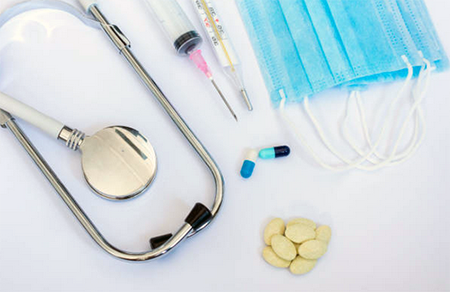Drug allergy: what you need to know


Over the past decades, the number of medicines and the variety of their trade names have increased significantly. On the one hand, this is good because it increases the effectiveness of the treatment of many diseases and allows people from every corner of the world have access to the most modern medications through generic drugs. But there is a downside: along with an increase in drug consumption, the likelihood of developing adverse reactions from their use, including drug allergies, increases. The statistics speak for themselves. Before the introduction of sulfonilides (late 1930s) in medical practice, complications of drug treatment were observed in only 0.5-1.5% of patients, and now only in hospital patients they occur in 15-30% of cases.
Allergy to medicines is associated with the reaction of the immune system to the ingress of a foreign substance into the human body - in this case, a medicine. Allergies can be caused by almost any drug, including antiallergic. But there are medications that cause allergic reactions more often than others.
In the ranking of the most allergenic drugs, antibiotics are in the lead. Especially often, allergies are caused by the so-called B-lactams (penicillin, amoxicillin, cefazolin, cefotaxime, etc.) and sulfonamides (streptocid, cefotaxime, etc.). In second place are non-steroidal anti-inflammatory drugs. This group includes almost all pain relievers and antipyretics sold over-the-counter. Local anesthetics - novocaine, lidocaine, etc. also often cause allergies. Medicines with iodine are also a frequent allergen. At the same time, remember that iodine contains most of the drugs used for X-ray studies with contrast (irrigoscopy, urography, angiography). Quite often, vaccines and serums cause allergies. Besides, there is a danger of cross-allergies, i.e. when being allergic to a certain medicinal substance, a patient is at risk of developing an allergic reaction to other medicines (see the table below).
Cross-allergic reactions to drugs (short list)
There are general rules on how allergic reactions to medicines develop:
1. Allergies can appear when taking even a minimal amount of medication.
2. Allergy to drugs develops only with their repeated use. But a few people can remember all the names of the drugs they have used before. The determination of allergy to a particular substance is also complicated by the abundance of combination drugs, i.e. the composition of a single drug can simultaneously contain, for example, and several antimicrobial agents, and anesthetic. It should be borne in mind that some drugs enter our body imperceptibly (for example, when eating meat containing penicillins).
3. It usually takes 5-7 days between the first use of the drug and the appearance of a drug allergy.
4. With repeated contact with the allergen (even several years after the first dose), the allergic reaction develops faster (usually after 1 hour to 3 days) and is often more severe.
5. Allergic reactions can occur when using a drug with a different name and even from a different group than the already known allergen drug. This is due to the similarity in the chemical structure of a number of drugs and is called cross-reactions. Some of them are listed in the table.
6. Allergy can occur not only to the active substance of the drug, but also to the auxiliary dye, flavor, etc.
The following factors increase the risk of developing drug allergies:

- Family predisposition to allergies;
- The presence of allergic diseases;
- Professional hazards;
- Fungal diseases of the skin and nails (increase the risk of allergy to penicillins);
- The need to use a large amount of medication;
- Self-medication.
Main manifestations of drug allergy
The manifestations of drug allergy are varied. They usually begin suddenly and can be very severe, life-threatening, with the involvement of almost all human organs. Examples of this are anaphylactic shock or the less well-known Lyell's syndrome (extensive skin lesions from the mucous membranes in combination with high fever and damage to the function of all organs and systems), etc. But more often reactions develop with a predominant lesion of one organ.
The most common manifestations of drug allergies are:
- Various rashes accompanied by itching,
- Urticaria,
- Quincke's edema (swelling of the organs, most commonly, face).

The rash is often itchy and usually localized on the upper body. With repeated prescription of drugs, dermatitis often develops in the same places.
Worth noting, a rash that occurs in children with infectious diseases (measles, rubella, etc.) is often mistaken for manifestations of drug allergy to antibiotic use.
An allergy can manifest as a drug fever (an increase in body temperature in response to drug use). At the same time, it is most often caused by the drugs most often used when the temperature rises - antipyretic and antibiotics. Cancellation of the drug usually leads to normalization of body temperature within 72-96 hours, but this decision can only be made by a doctor.
Allergy to drugs can lead to a variety of respiratory disorders (from rhinitis to severe asthma attacks). More than 23 lung reactions are associated with aspirin and other pain relievers, although, they are not purely allergic. Not precisely allergic in nature but common manifestations/adverse reactions that commonly occur are cough, nasal congestion and bronchospasm when taking certain heart medications (anaprilin, metoprolol, atenolol, enalapril, captopril, monopril, etc.).
Allergy to medicines can cause changes in the blood test - a decrease in the number of leukocytes, anemia, etc. Somewhat less often, with drug allergies, there is damage of the kidneys, heart, blood vessels and spleen.
Safety rules for drug allergies

1. The exact name of the allergenic drug and the group to which it belongs must be known both to the allergic person and to his or her relatives.
2. When contacting a doctor of any specialty, always warn them that you have had an allergic reaction to the medicine.
3. If you are allergic to any medicine, then you should not take it at all. It is very dangerous! Reducing the dose does not affect the likelihood of developing an allergic reaction.
4. Don't self-medicate.
5. Carefully study the composition of the medicine you are going to take. The same drug produced by different companies may have different trade names.
6. Be very careful when taking medications containing several components at once. One of them, not necessarily the main one, may be just your allergen.
7. Remember the cross-reactions (see table).
8. If you are allergic to pollen, then you should refrain from treatment with herbs and preparations with herbal ingredients.
9. Be careful with long-acting medications.
Treatment of drug allergy
The most effective treatment is knowing the drugs you are allergic to and avoiding taking them. But if you just started the treatment and have developed allergy, for instance, skin rash, first of all, discontinue the drug use and inform your doctor. Secondly, take an antihistamine drug such as Periactin (Cyproheptadine). If you develop severe adverse reactions such as suffocation, face swelling (angioedema) – seek emergency help.
Post by: Kylie Richardson, General Practitioner, Rotterdam, Netherlands
(Updated at Apr 14 / 2024)
Periactin articles:
Some of the trademarks used in this Web Site appear for identification purposes only.
All orders are reviewed by a licensed physician and pharmacist before being dispensed and shipped.
The statements contained herein are not intended to diagnose, treat, cure or prevent disease. The statements are for informational purposes only and is it not meant to replace the services or recommendations of a physician or qualified health care practitioner. If you have questions about the drugs you are taking, check with your doctor, nurse, or pharmacist.